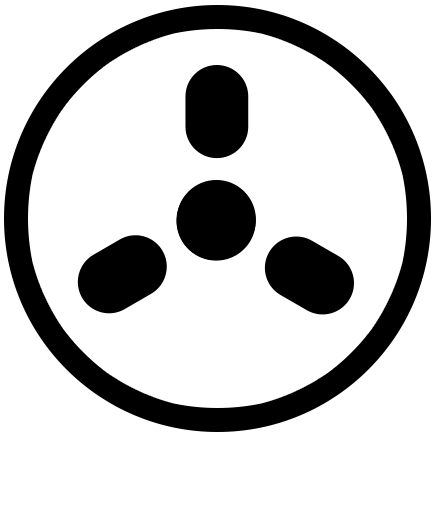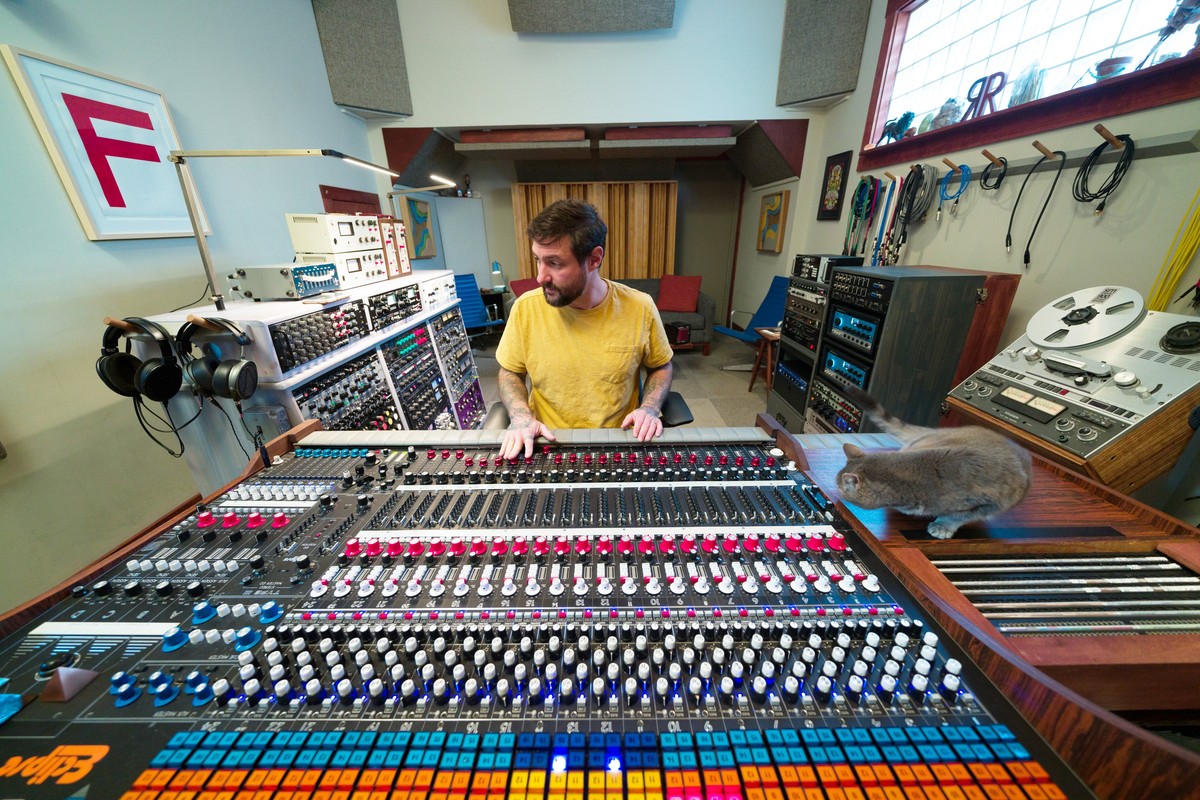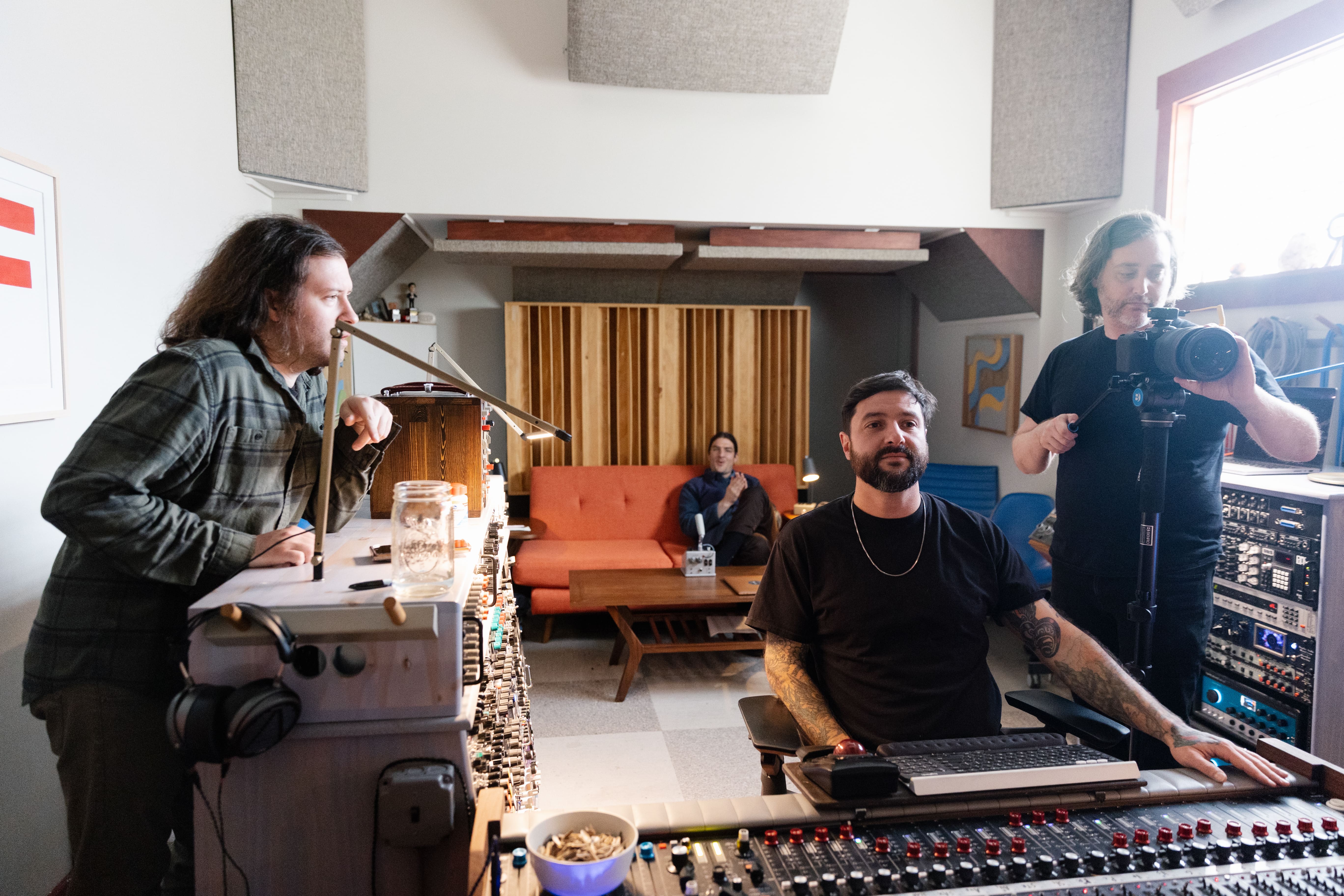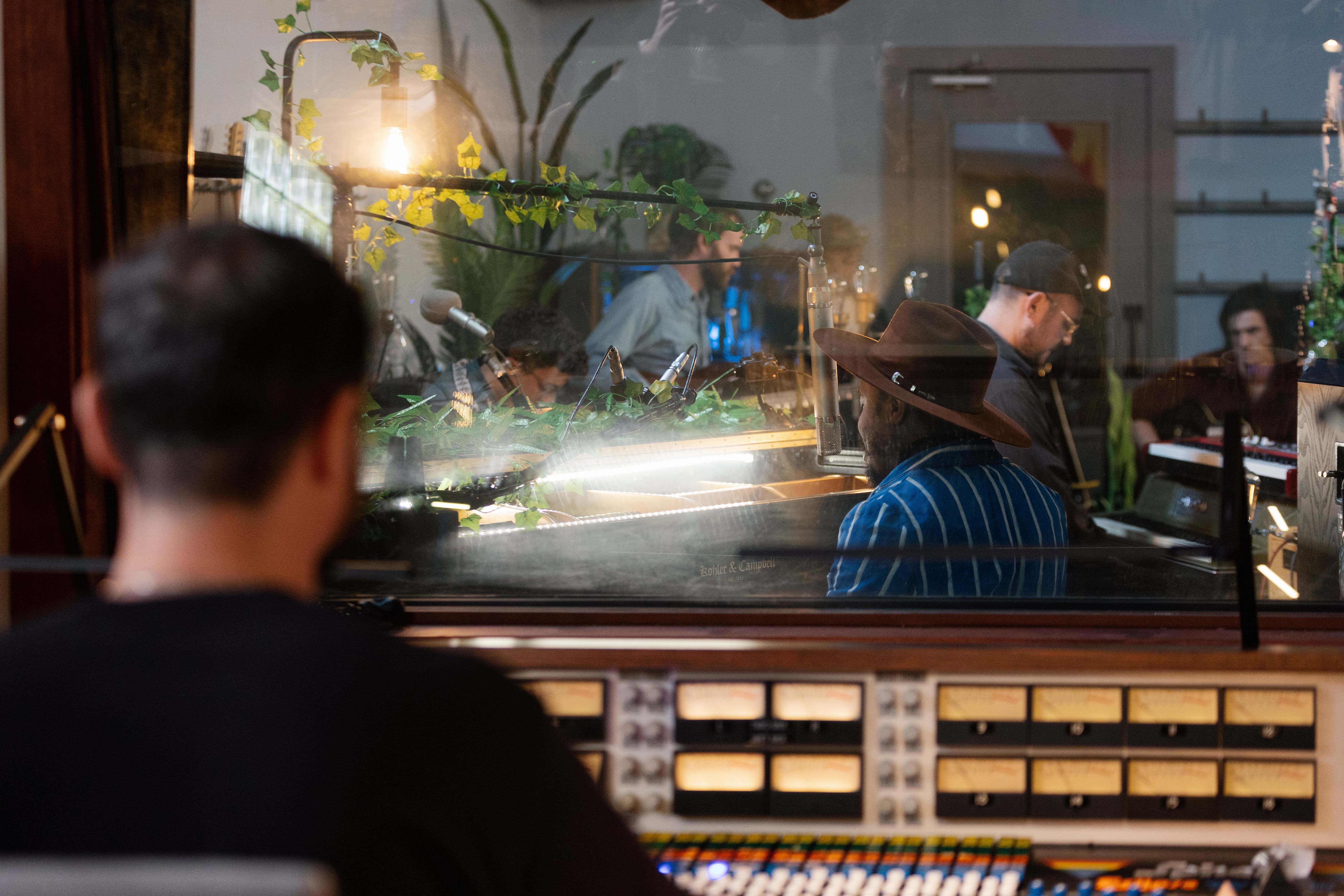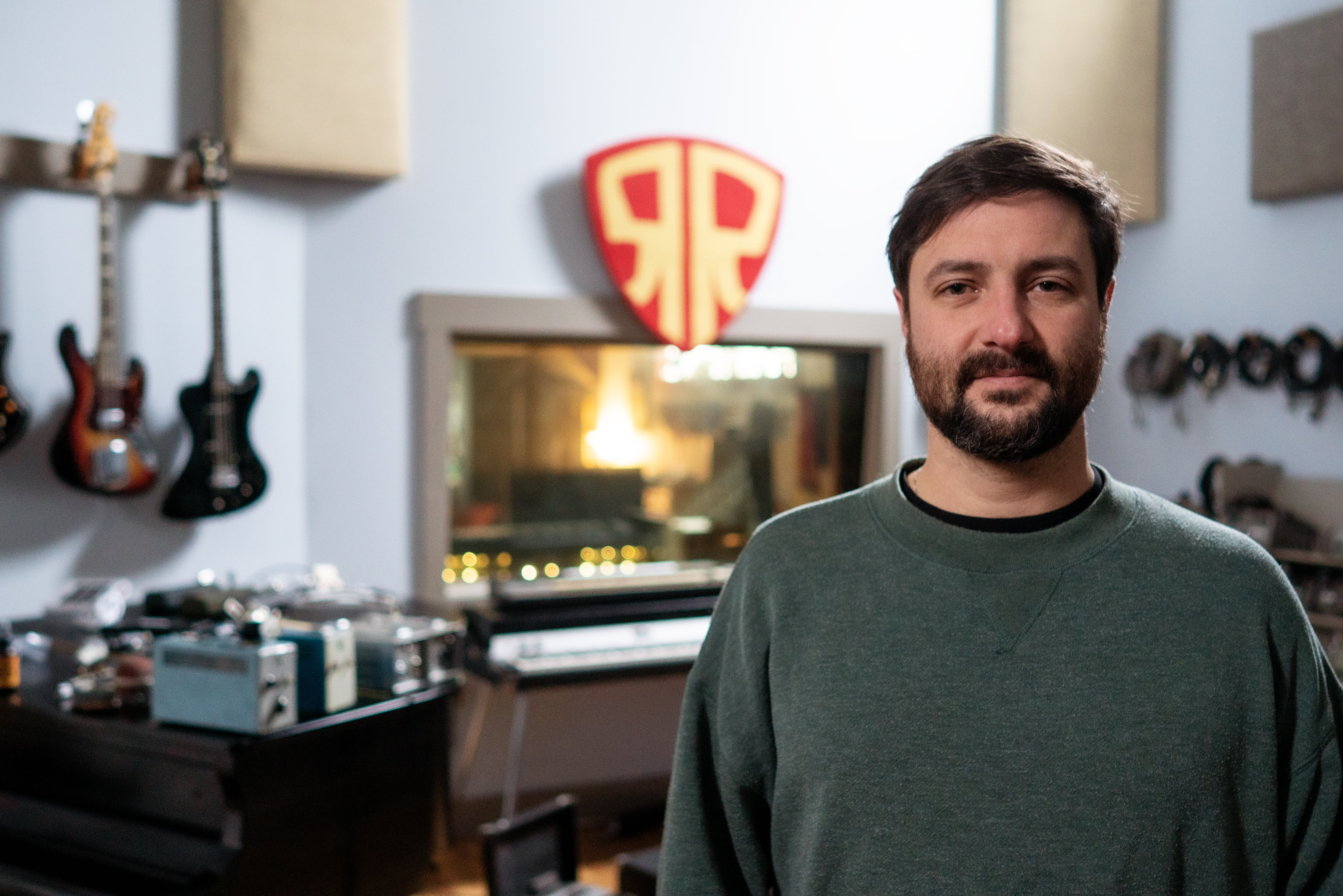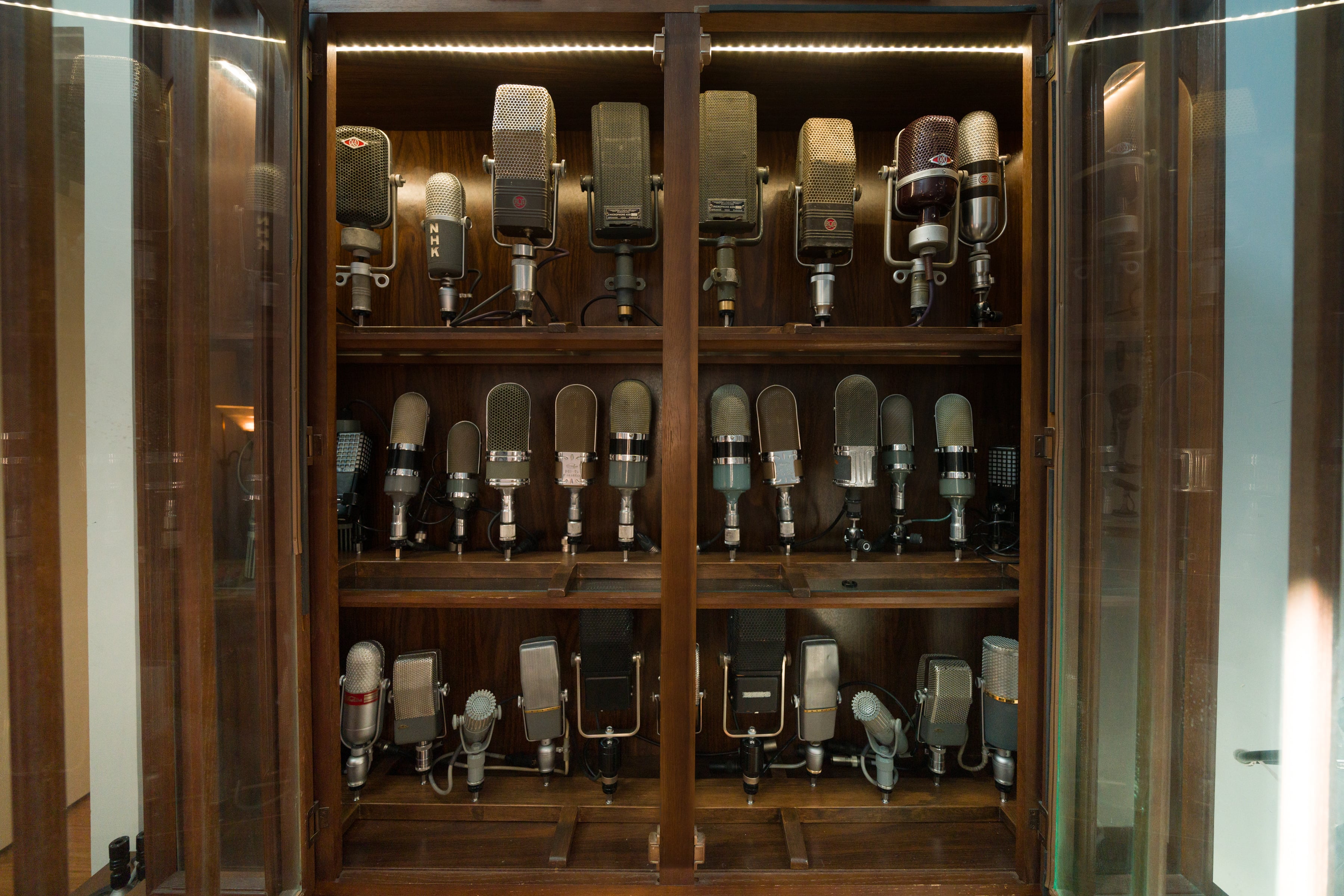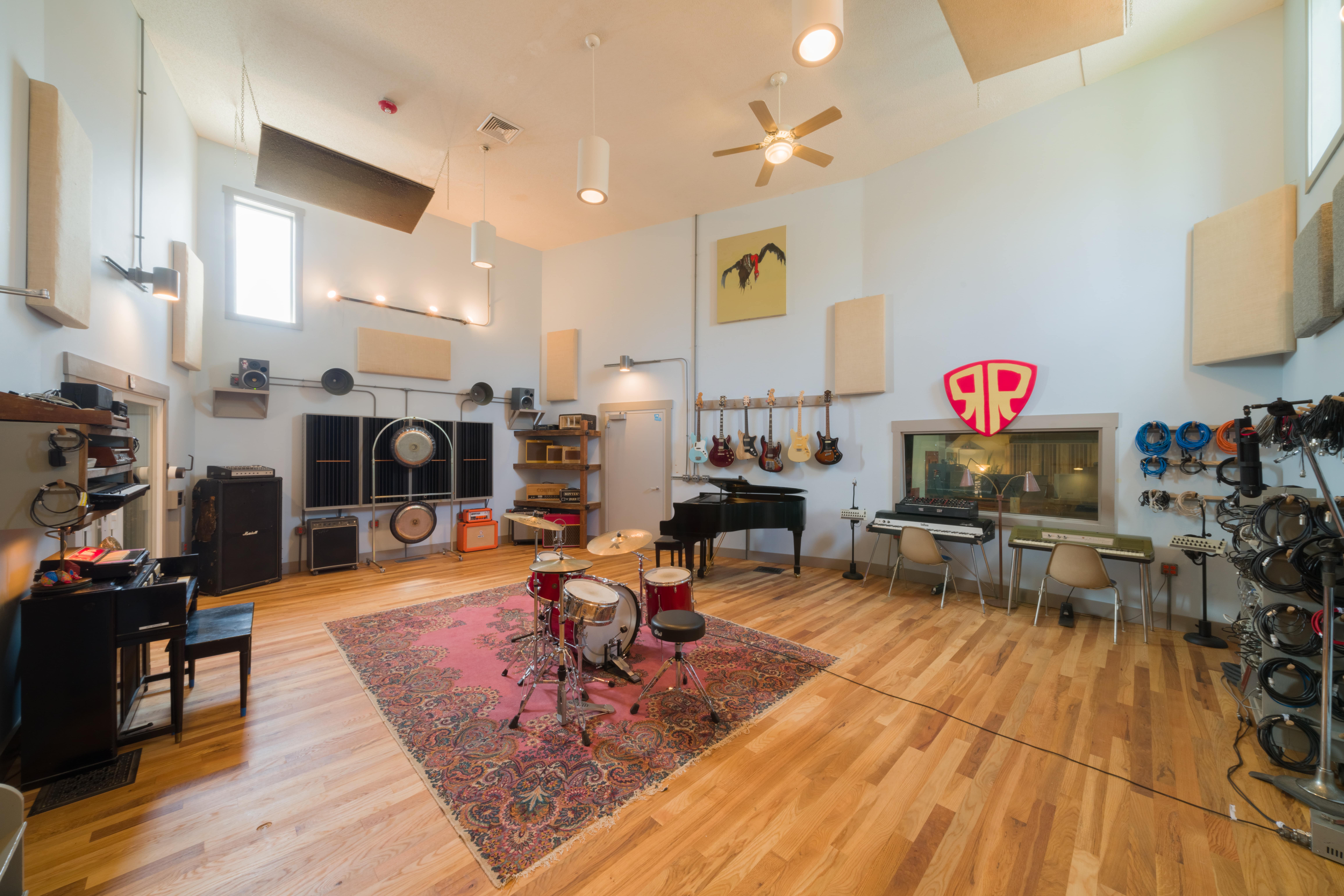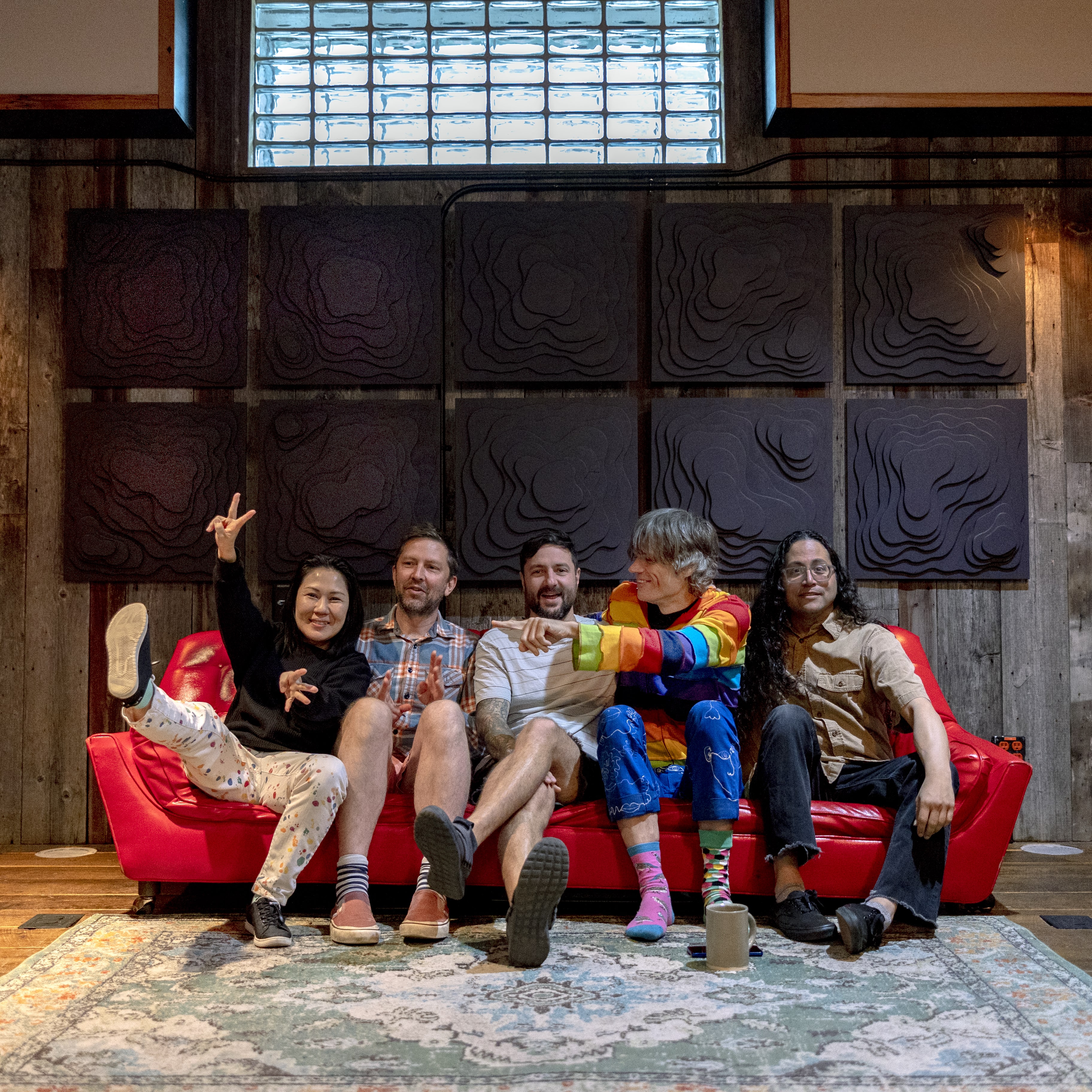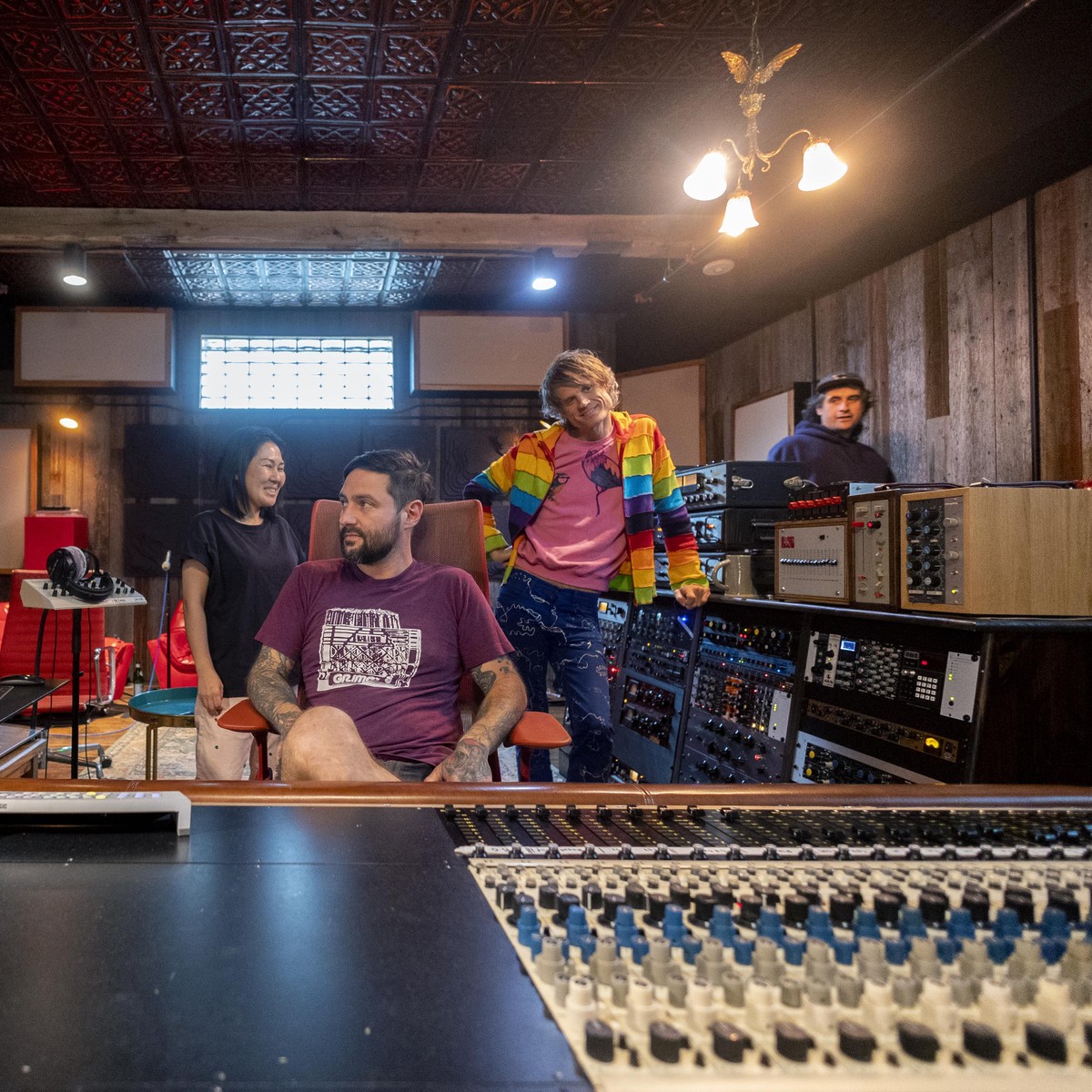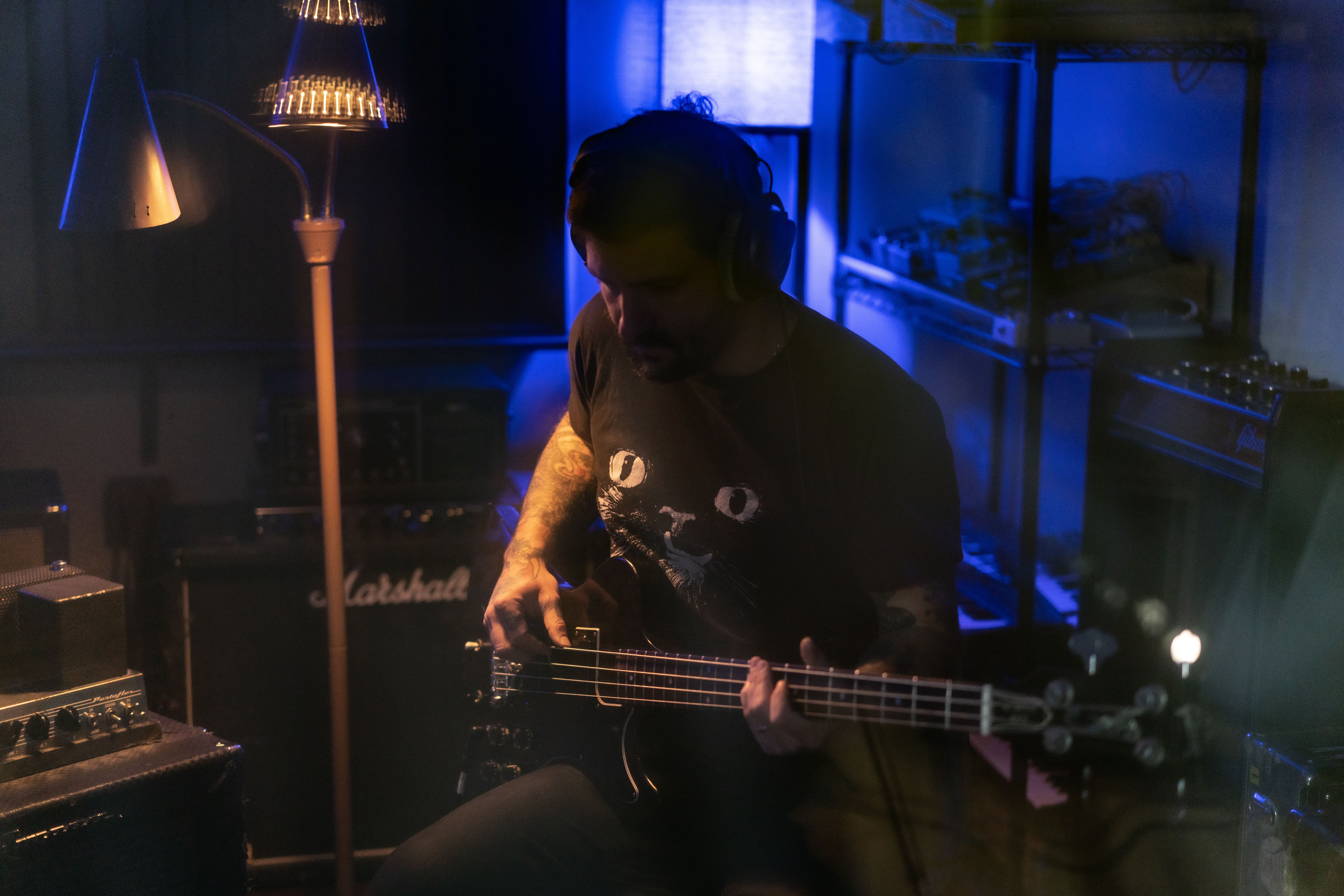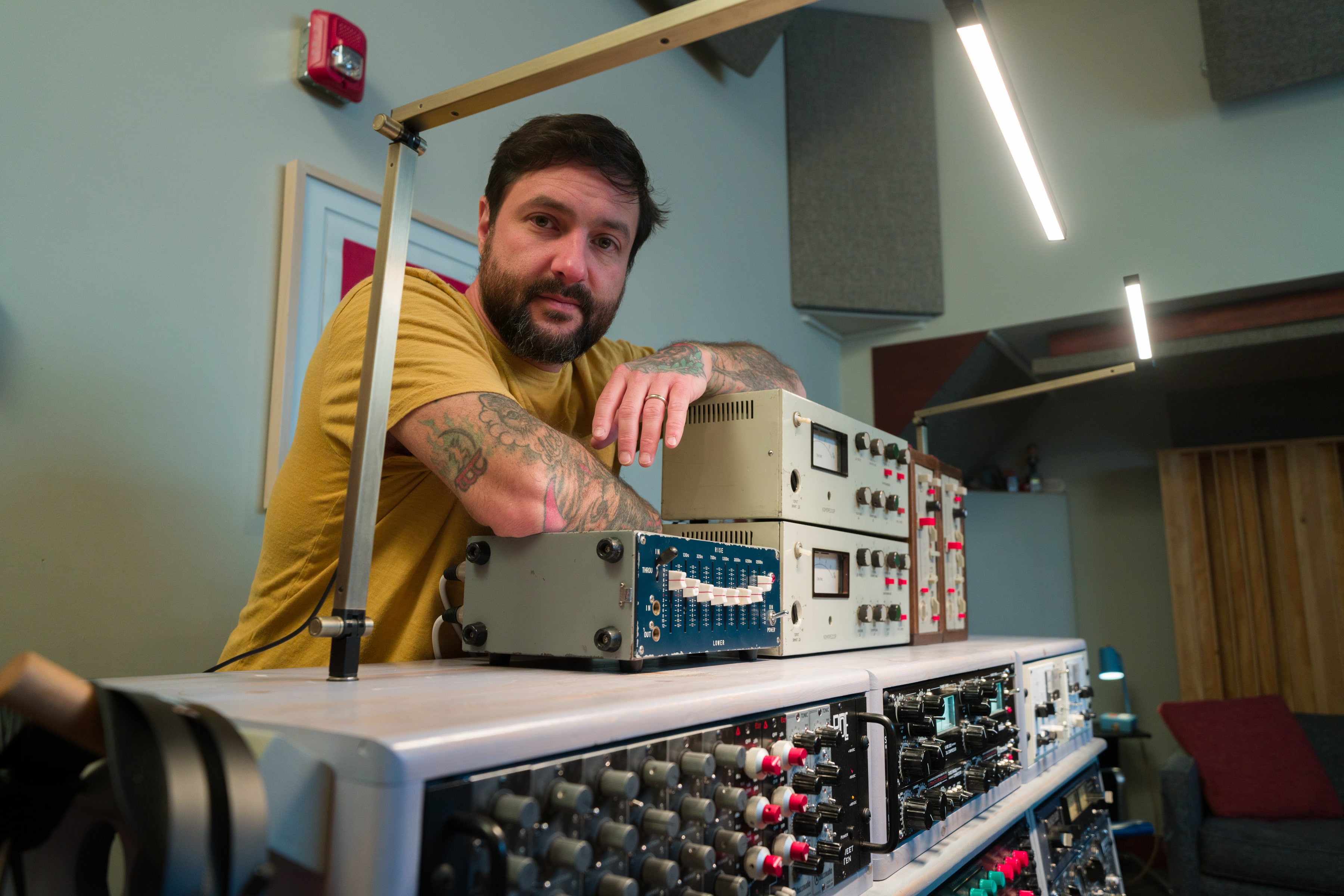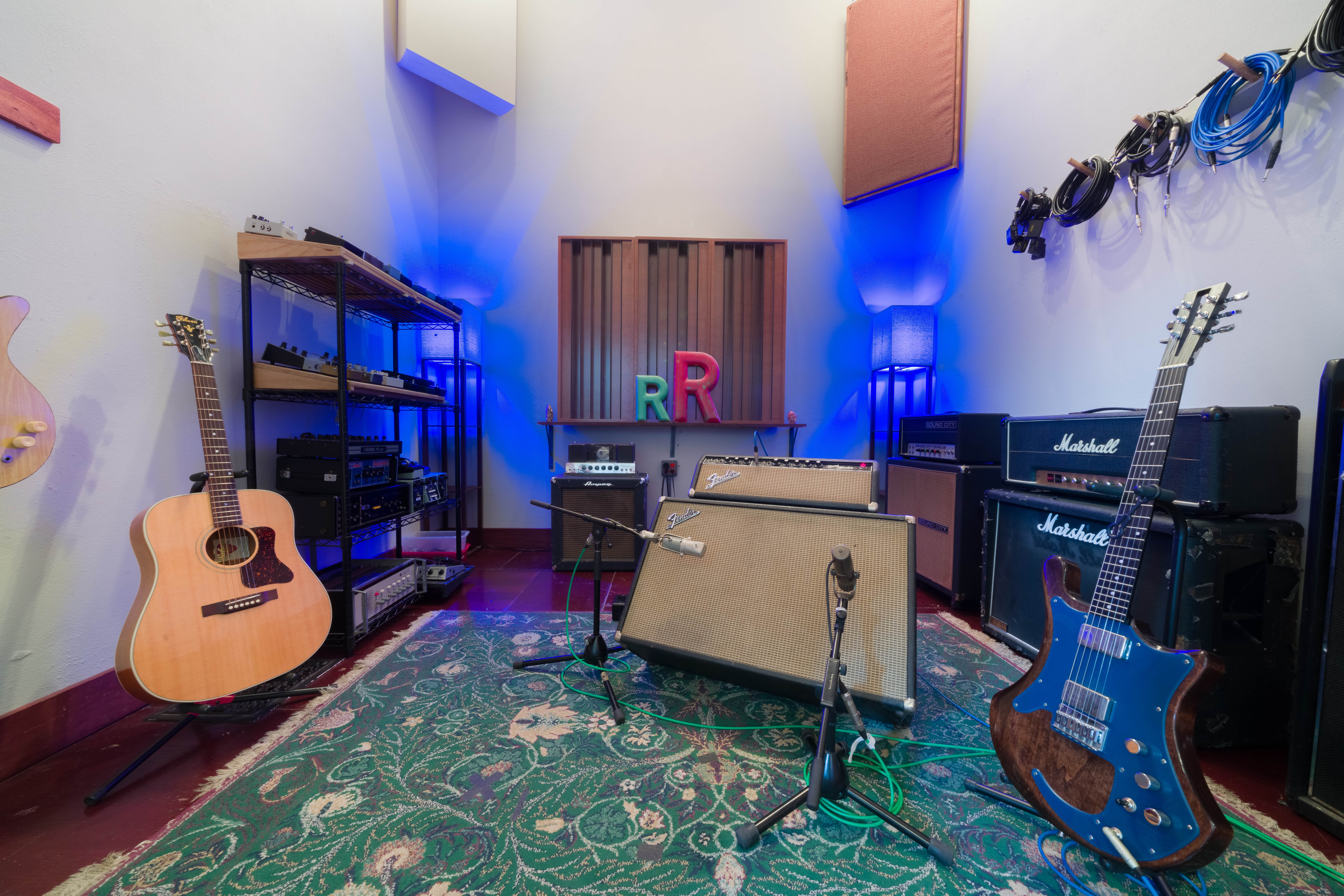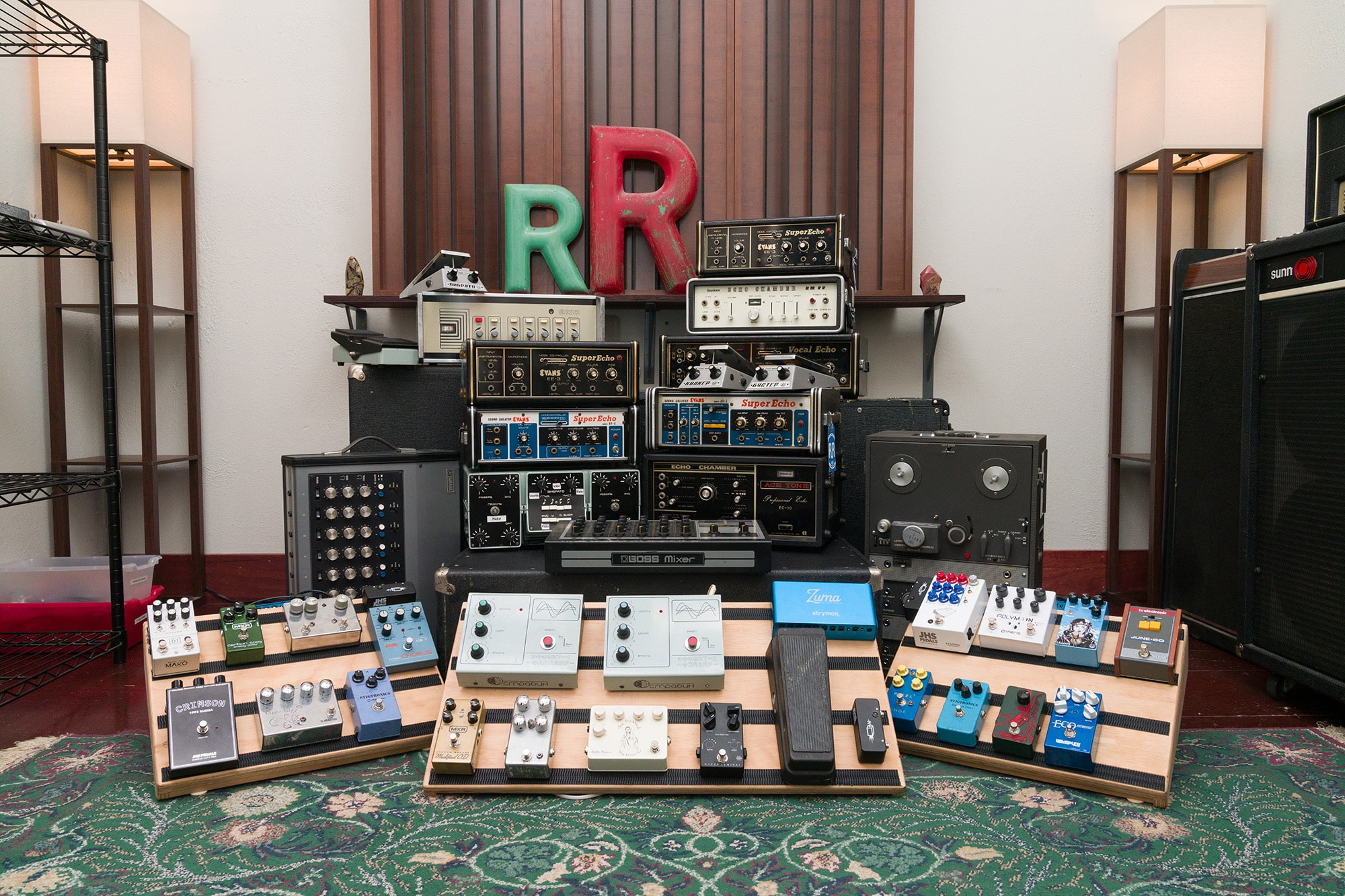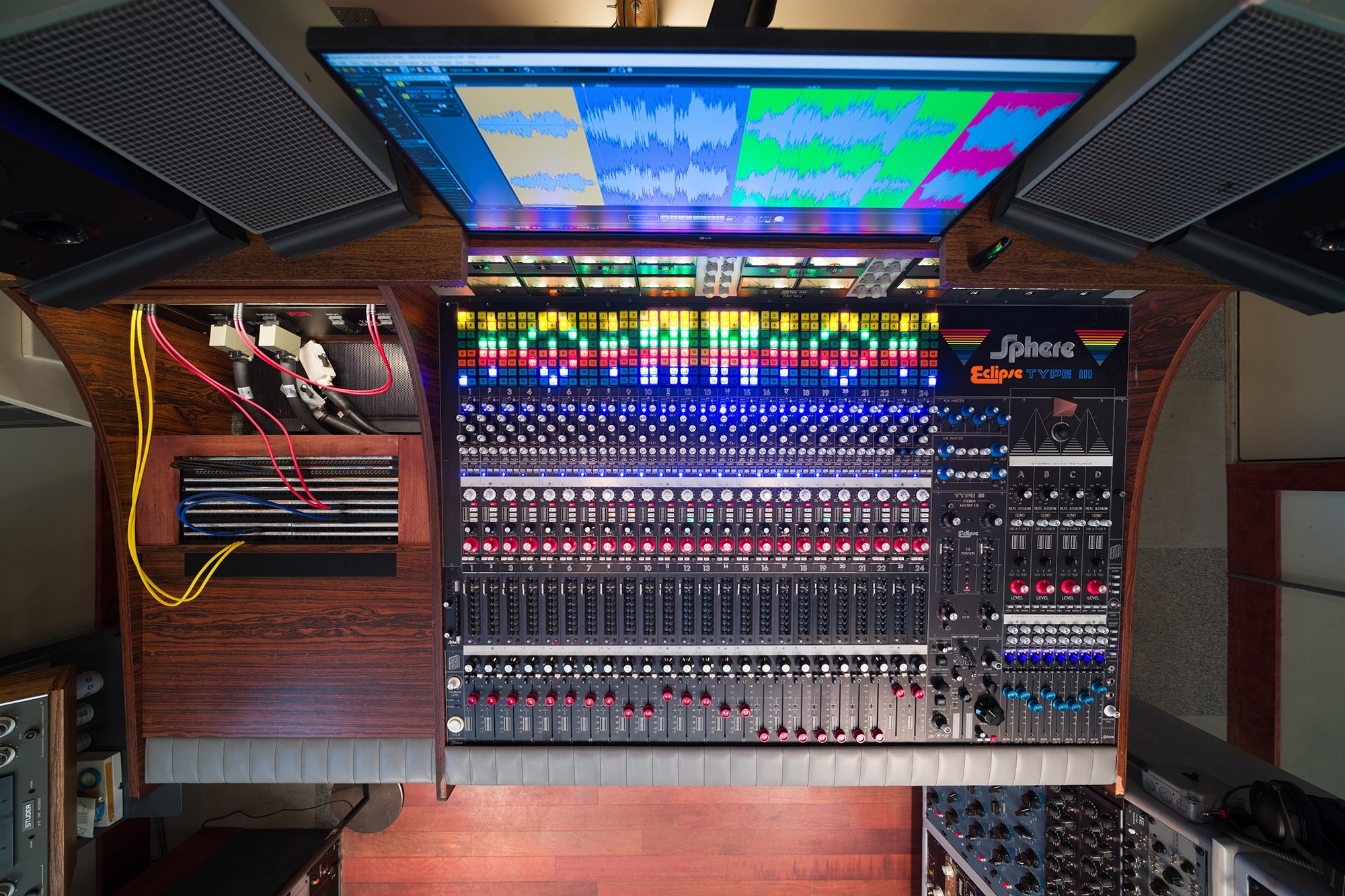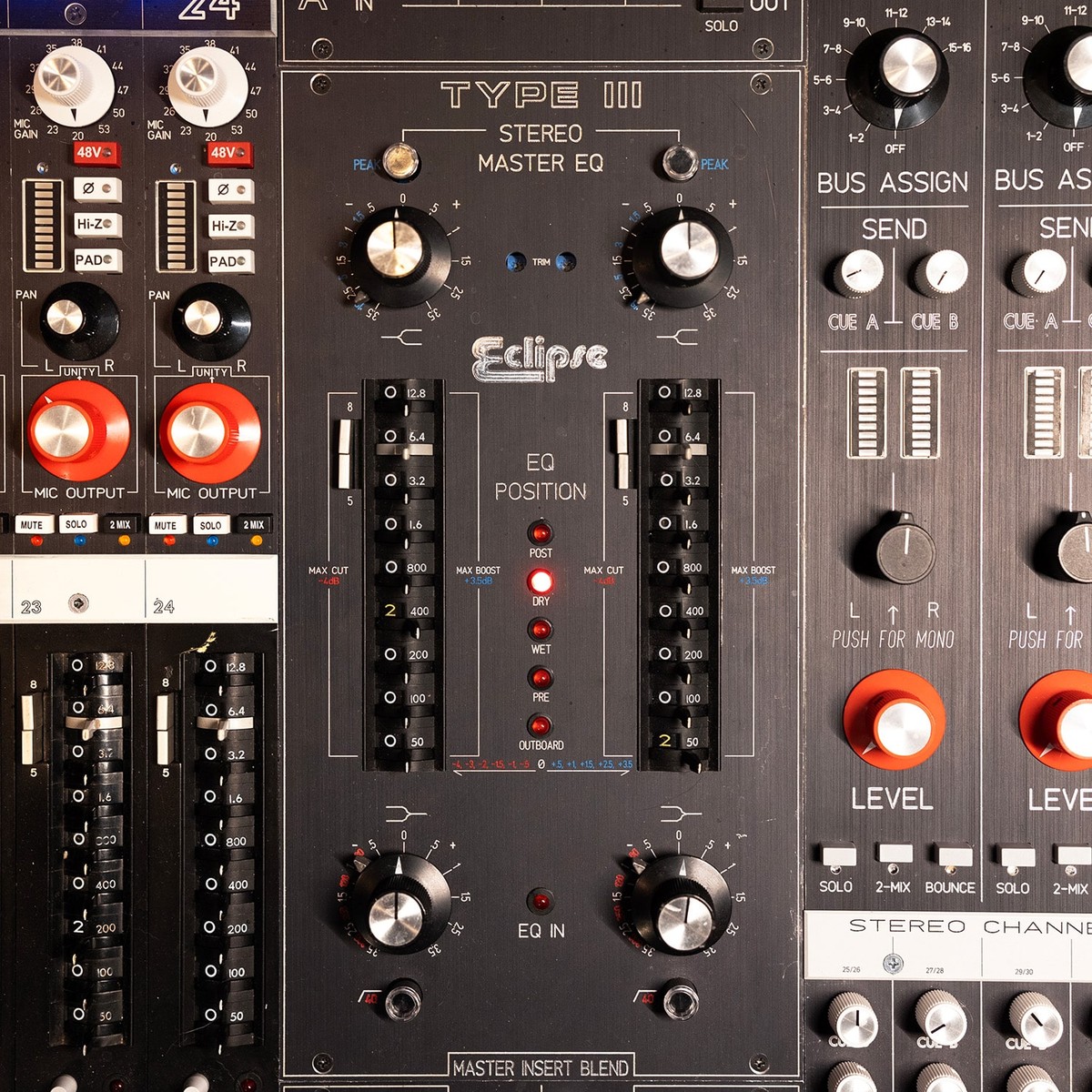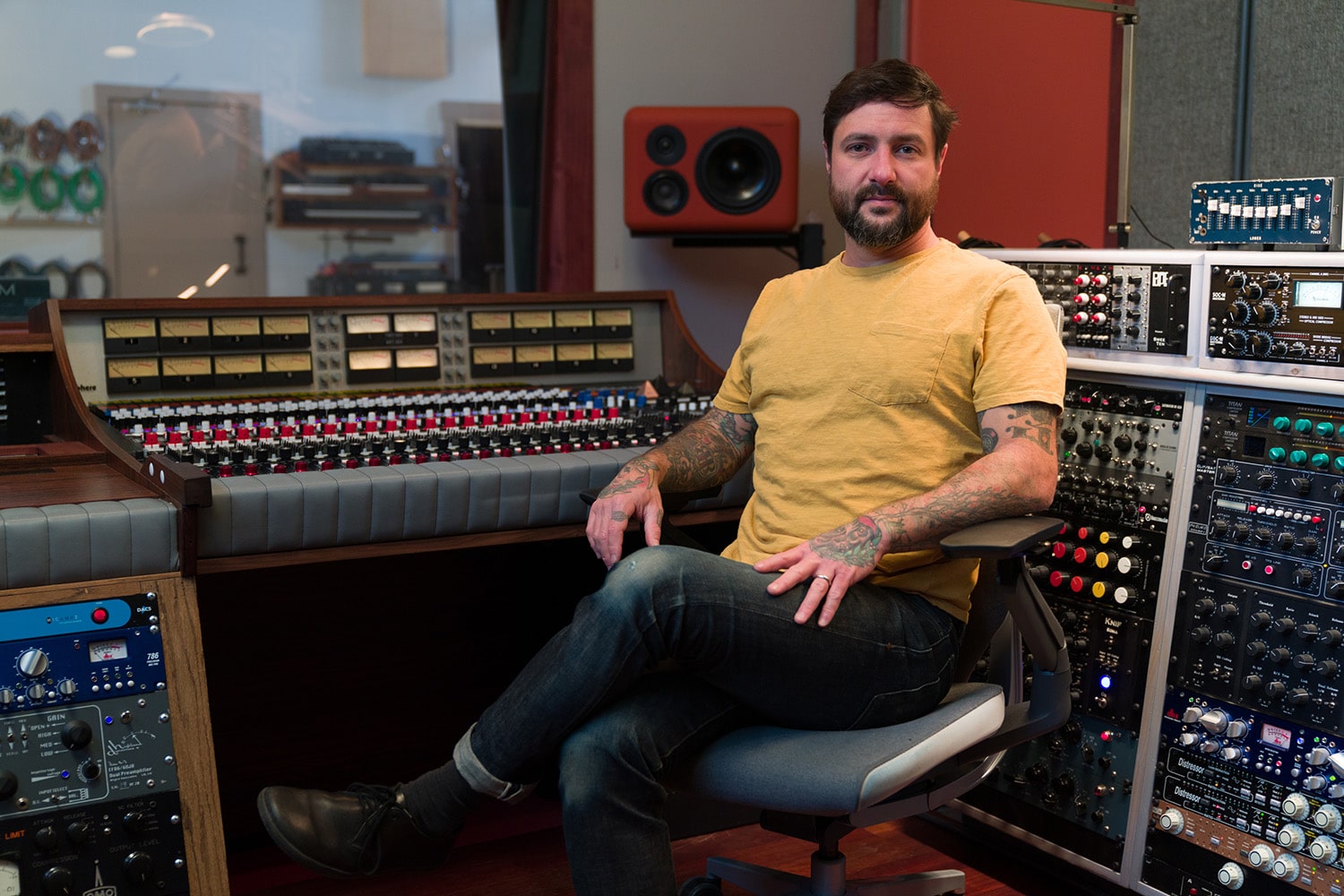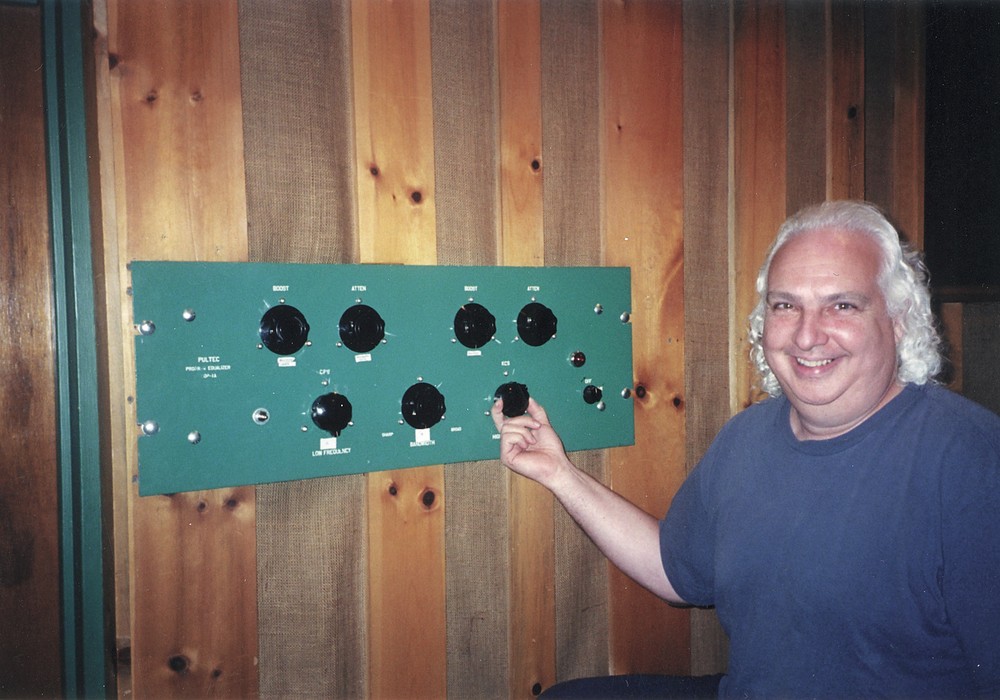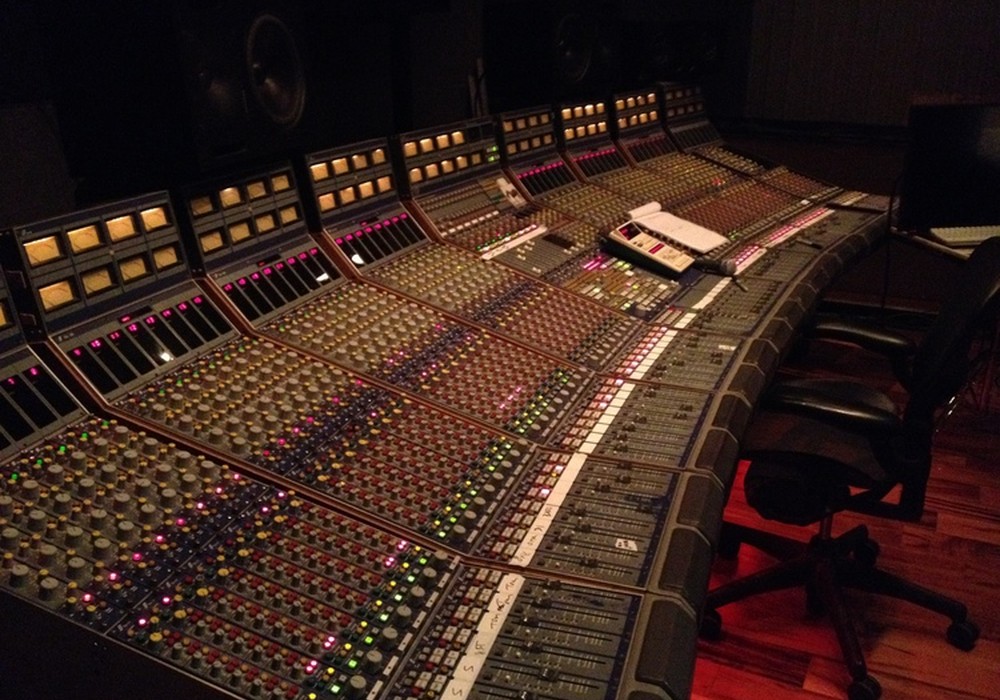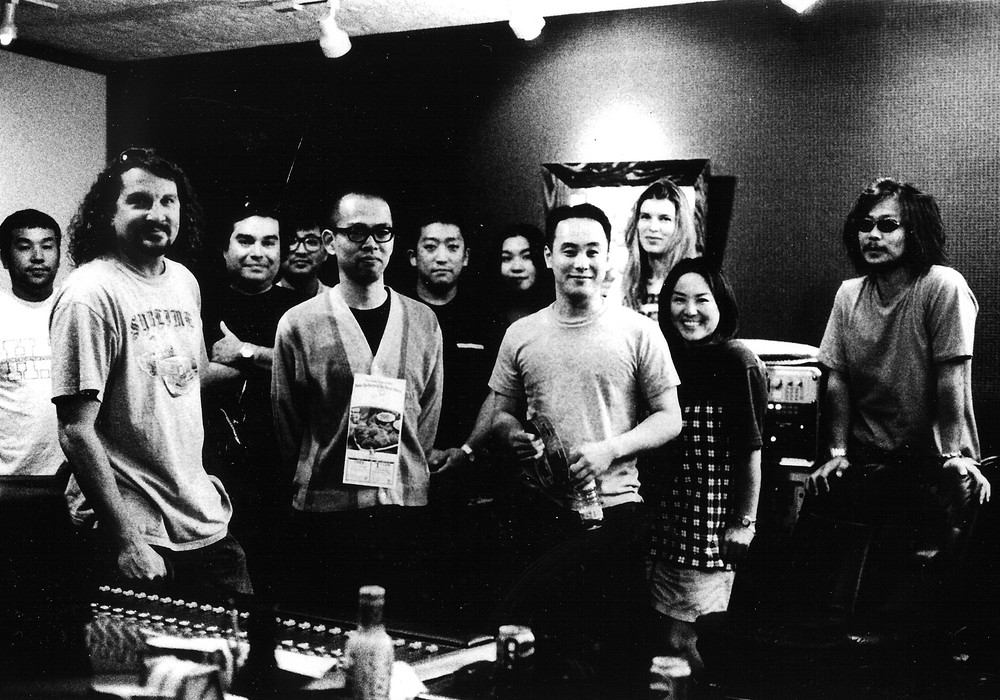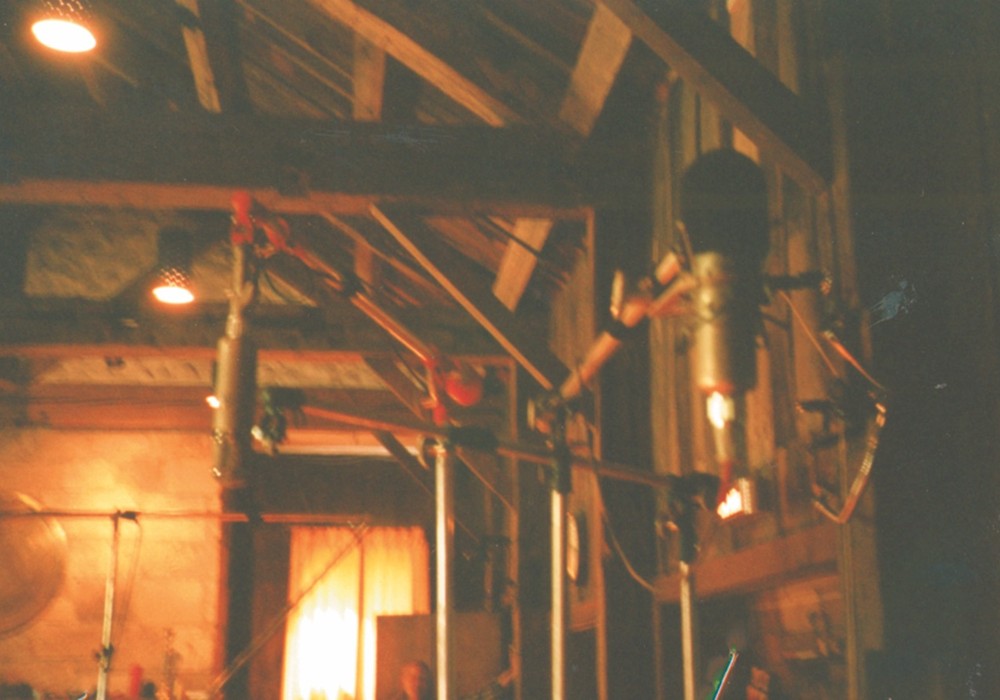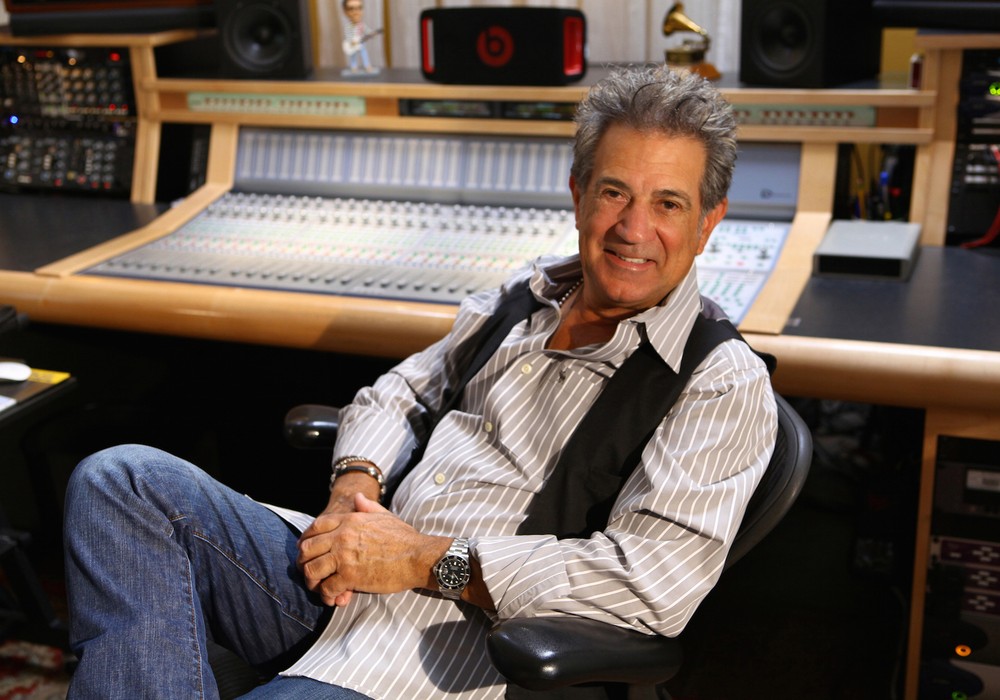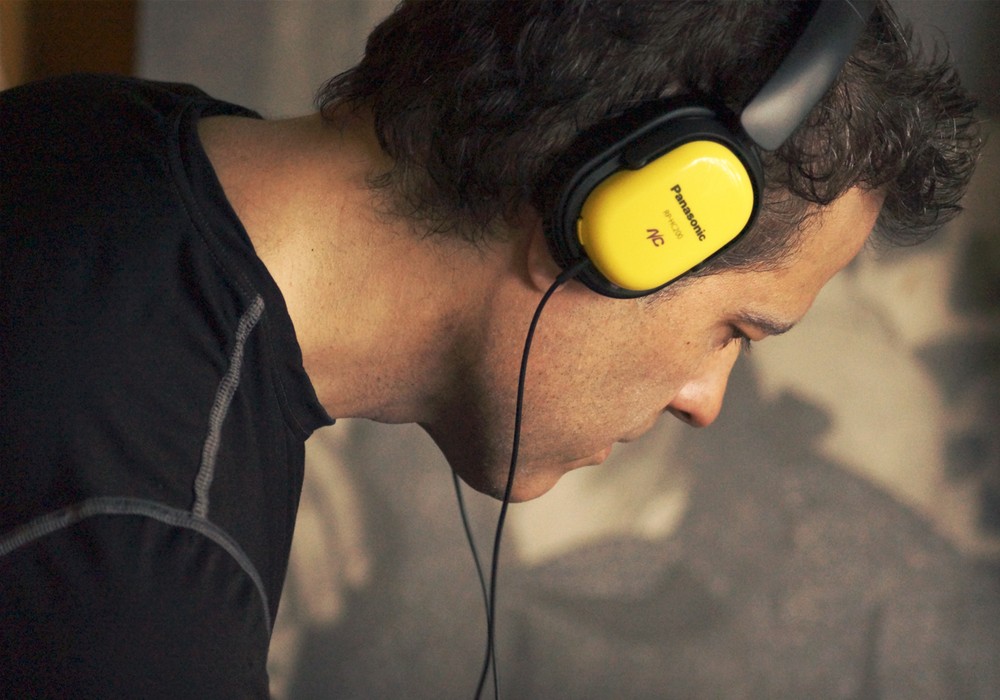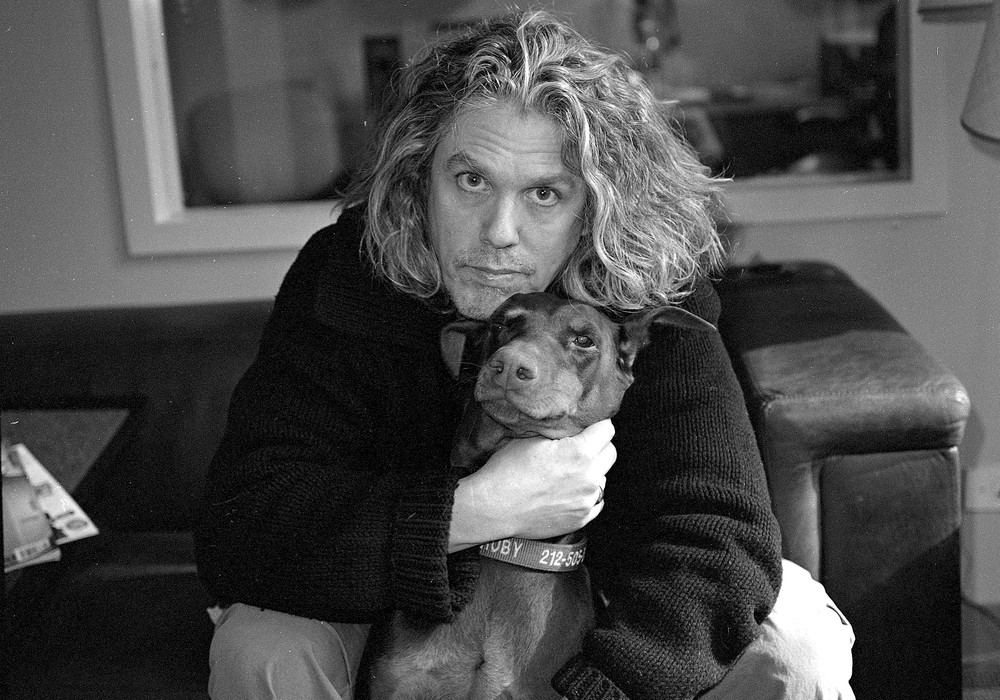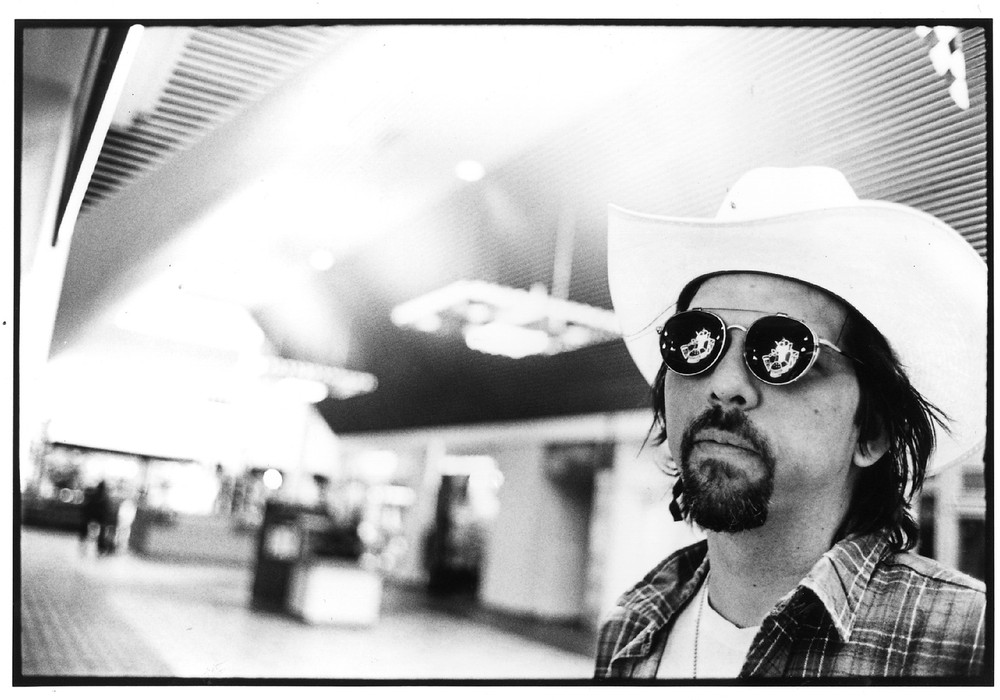Greg: You probably hold the world record for most albums created in the shortest time, at the lowest price. I'd think you'd need some repeatable formula. But your actual work is all over the place!
Everyone loves custom stuff. Skateboards, cabinets. My own console is ridiculously customized. To me, there's nothing more custom than recording someone's project for them! But sometimes bands will say, "I want my drums to sound like this song." I've learned that they usually just want the listener to feel the same thing they feel when they listen to that, which has little to do with the recording. I've had a drummer mic'd perfectly, and another really good drummer plays the same drums, and they sound totally different. So many variables, including the player's mood, go into making something sound the way it does.
Ed: I'm sure there are people who would want a specific sound that a producer's known for, even if they don't have a human connection. But to me, the fascinating part about a recording studio is the social aspect. A lot of people who get into the business don't think about that.
When we get wide-eyed interns staring at all the knobs and buttons in the control room, I tell them the most challenging part of this job is being a psychologist. Meeting a new band, learning all their names, and very quickly deciphering their inner dynamics. "This is the person who's never been in a studio, and they're super nervous. I have to make them comfortable. This is the person who thinks they're great at everything, but they're actually not. This is the person who is going to have a bunch of ideas that no one likes, but if I turn them down they're going to go down a hole and perform terribly." I have to find a way to earn everyone's trust, without offending anyone or putting them on edge. Part of navigating that is not minding if people get mad at me. I can jump in and say, "Hey, man. I'll be honest; you're dragging on the bass." If the singer tells the bass player that, there can be hurt feelings or unnecessary conflict. I firmly believe that achieving camaraderie in the studio is the key to the success of an album, and that the bonds we form through the experience of creating and documenting art directly inform the final product.
G: Is that because you're in Bloomington?
[laughs] There's a Midwestern element to it. I interned at Electrical Audio, and admire the Steve Albini [Tape Op #10, #24, #87] ethos of being there to serve the band, not yourself. It makes sense they'd know best – they've already formed the band, worked out their relationships, and written the songs. At the same time, I'm not an extreme hands-off, none-of-my-business type of engineer. If I hear a bad bass note, I'll be honest and confirm whether or not it's intentional. If possible, I try to get to know the band beforehand with a phone or Zoom call. Some artists are eager for a producer to tell them what to do to make them stars. Damion Schiralli, another engineer/producer at the studio, is great with that. He can play any instrument, in every genre. I don't have that kind of resume. I prefer to work with bands like you guys, that have a specific vision in mind that I can help achieve. If a band doesn't know what they want, and it's my responsibility to turn it into something, I'll start my own band for that.
G: You named your studio after your family's heritage, but Russian Recording is also home to a large collection of Russian equipment, mostly microphones.
Yeah, I'm obsessed with high-end Soviet microphones, analog recording equipment, synths, amps, pedals, and outboard effects. The history is fascinating, and their industrial design is in a league of its own.
G: I grew up with the stereotype that Russian manufacturing and engineering were low quality knockoffs of what they couldn't get from the West.
But that's the stuff "for the people," made as cheaply as possible. The most cherished mics I've acquired were developed for orchestral recordings, government speeches, and especially for cinema, which Vladimir Lenin considered the most important art form. They weren't designing gear for capitalism or export. These are handmade relics, and way over-engineered. In some cases, less than a dozen were made.
G: We've all been recording for over 30 years, but opening our own studio always seemed too risky. What went through your mind when you made that decision?
I'm a fool with finances. The reason it's worked out isn't that I want to be rich or famous. By age 14, I knew I wanted to go to audio engineering school. I interned at Great Tracks Recording [Cleveland, Ohio] during my senior year of high school, then went through the Indiana University recording program, and then Electrical Audio right after graduating. I opened Russian Recording in 2003. Bloomington had a vibrant local scene, with great bands. I started telling them all, "Hey, I have this studio." It was DIY from the beginning. I rented an A-frame ski lodge in the middle of the woods. This was before smart phones, and bands loved to go out there, because they'd bring food and camp out at the studio. No internet, no distractions, just making records. I charged $250 a day, maybe 16-hour days, but I didn't care, I just wanted people to record with me. I loved that by the end of a five-day session, we'd all be best friends with a half a dozen inside jokes. Then I don't see them again until they come back a year later to make the next record. That's been my life. To fund this, I worked full-time jobs while also learning CAD [computer assisted design], researching how to build walls, and drawing up studio plans. By 2008 I was ready to build my own studio. I walked into the bank with a stack of records I'd produced and said, "I want to build a studio in downtown Bloomington. It's going to bring in people and put Bloomington on the map for music." This was 2008, the worst time to be asking for a bank loan. The loan officer said, "We should not give you this," but somehow, she believed in me. Then it was months of me and my buddies drywalling, wiring patch bays, and installing HVAC. Of course, the electrical cost way more than I'd expected. I was unemployed and in enormous debt. My very first session was recording the electrician for free for three weeks, in a studio that was still barely working.
Out of nowhere in 2011, my cat, Lil BUB, came into my life. She pulled me away from the studio for a few years; we ended up doing a lot of wild stuff together, including her own talk show and the first national fund for special needs pets. The DIY guy in me was like, "I'm doing it all myself. " It just kept getting bigger, and it took over my life. Lil BUB still has a presence in my life , even though she passed on four years ago. We have a nonprofit [Lil BUB's Big Fund] that was started from that for special needs pets, and my wife, Stacy Bridavsky, is the director of that. It's a very big part of our lives, but when BUB passed away in 2019 I focused all my energy back into my studio, with more passion than before. I figured out it can be sustainable business model, if you do it the right way.
G: What advice do you have for someone who feels like they're approaching burnout?
This job is not for everyone. I had to set some rules, especially when my kids were younger, and that was hard at first. "I would like to start at 9 a.m. At 5 p.m. I'm going to go home to have dinner and put my kids to bed. If I don't pass out, I might come back at 8 or 9, and we can do some more stuff." I would either arrange to have one of the other engineers fill in while I was out, or tell the band, "While I'm gone, why don't you work on that synth part that you haven't figured out, but are adamant about playing?" Or, "Listen through the takes and make notes." The bands loved it!
G: Time management might not sound very sexy, but I respect that you're willing to deromanticize the self-punishment model of making art. Deerhoof suffers from the same temptations of burnout. The fact that you had a daily framework helped us relax. "This is not going to be grueling test of survival."
I learned that from experience. When I started, I was all about not sleeping. "I'm going to be in the studio, chain-smoking for 20 hours straight!" But your record is going to come out much better if no one gets ear fatigued, and we can joke and have a little fun. I record bands on very tight budgets. Recording can be an intense, stressful, and inescapable situation. Clear communication and synchronizing expectations are crucial. Everyone who's ever made a record knows there's that point of diminishing returns. It's 2 a.m., you're trying to get that guitar part, and it's not happening because we've been at it for 13 hours, and every instrument sounds out of tune. Lately I've been booking sessions in small blocks. A night of setup, three or four days of bed tracks. Then a break, listen to the rough mixes we made on the last day, and figure out your overdubs. Then three days of overdubs and new roughs. Another break before mixing. When you return, you already know, "The bass is a little boomy." Or, "The chorus needs a tambourine." Fresh ears are critical for making a great record. I can accommodate a lot more bands on the calendar this way. It mixes things up, so I never get too "in the weeds" on any one project. Sending me demos beforehand helps a lot. If I already know what their songs sound like, I'm more into trying something special to suit the songs. I always ask if they're game; I'm not pushy. But, for example, after listening to demos from this band Nice Try, I said to them, "These songs all sound a bit similar. I've divided them into three categories: The slow, jangly songs, the super catchy rockers, and the aggressive punk rock ones. What if, for all the jangly ones, we'll only use dynamic mics, the drums will be in the big room, guitars in the medium room, and vocals in the small room? For the catchy songs, we'll only use tube mics, the drums will be in the dead room for that dry sound, and vocals in the live room?" Now I listen back, and I don't remember which was which. But they sound cool, and I can feel a subtle sonic movement. Or this great local artist, [Justin] Vollmar, owned a Tascam 234 cassette 4-track. It's their highest-end model, but still, we're talking a track width of 1/32-inch and a recording speed of 3.75 ips. For this record, Open Window, I thought it would be great to use my professional studio, the nicest mics, feeding our Sphere console and outboard gear, but record onto this 4-track. For vocal harmonies, everyone gathered around one Electro-Voice RE55 and did it live to one track. We mixed directly to 1/4-inch tape, so it never went into the computer.
G: Deerhoof's fear of taking a producer into a well-stocked, fancy recording studio was that it'd be the opposite of what you just described. We'd be paralyzed by the infinite choices. We have to go in already knowing which toys we're using. We have to be able to make snap decisions. There's an irony that getting creative often means limiting yourself.
Deerhoof's Miracle-Level was a prime example. You said right from the start, "The only overdubs we want are claps, organ, and piano." That defined the sound of the record. Time being the biggest limitation, I suggested you record your instrumental tracks in complete live takes. You were hesitant, but I was so stoked that you went for it in the end. I like to commit to sounds on the way in. I never mix in the box. I'm usually recording digitally, but I need an analog console. For many, using a console is about the sound, and it's true that certain consoles have their sound. Or you hear, "Outboard gear's better than plug-ins." Sometimes it is, sometimes it isn't. But I'm not even arguing that. I'm a kid at heart and want to have fun, like a mad scientist. I must turn knobs and push things. I hate clicking around or looking at a screen too much. Perpetual tweaking through limitless possibilities leaves too much room for indecision. When I first opened the studio, it was simple. I'd tell clients, "We're mixing the song through the console to this 1/4-inch Studer B67 reel-to-reel deck. We'll make sure everyone thinks it sounds good, I’ll print it to tape, and then that's it; we're moving on. You're trusting me to know how it translates."
But some people would get nervous. I'd tell them, "All these little things that you're thinking about right now, you're going to listen back to this record ten years from now and have no idea what those things were. You're just going to hear the record for what it is." But Bloomington is a college town. I get older and everyone stays the same age! [laughter] As more people have gotten used to mixing in the box at home, some were adamant about being able to fix things later. That's when I realized I'm going to have to change the way I work, in order to accommodate that. You saw the system I developed.G: Can you describe that system for the readers? I'd never seen that before, and I thought it was really smart.
I came up with this process in 2009 or 2010, when I recorded Brett Eugene Ralph's Kentucky Chrome Review. A classic country record, with so many layers. Will Oldham was on it, and there were something like ten banjos, seven guitars, a Wurlitzer, and an unbelievable amount of fiddle. Mixing was insane, and Brett wanted to be able to tweak the mixes. That's when I developed this process. I printed the stereo mix, and then I soloed the drums and printed them to a stereo track. I soloed the bass and printed it. I did that for all of the instruments, until I wound up with a couple dozen stereo stems of each instrument group. Each with the processing through the console and everything.
G: Nothing on the master channel?
I printed two versions: One with the bus compressor and EQ, in case the mix was perfect, and then a dry version. I put the dry version in the DAW, with all the individual stereo stems below it, which theoretically should combine to make that exact same mix. I did the ultimate test: I inverted the polarity of the mix and pressed play. It was 100 percent silence! The only thing I could hear was the combined noise of the console from each pass and the dither in the converter. If someone comes back a week later and says, "This one syllable is too loud," I'd find that syllable on the vocal stem, invert it, and sneak it in to turn it down. We can even re-EQ, like we did on your record. If something's too bright, I do a high pass at 7 kHz, invert the polarity, and slowly bring it in and make that element darker. With these phase-linear plug-ins now, we can do just about anything and without artifacts. I have yet to encounter any scenario where I couldn't fix something with this method, because the mix is usually 95 percent there already and we're only using the stems to make minor adjustments. But bouncing took a long time. A five-minute song with 12 stems; that's an hour, and if I have ten songs, that's a whole extra day. I've fine-tuned this process since then. Part of the design of our newly rebuilt and redesigned Sphere Eclipse Type III console (see console interview here) was to include a stem bouncing feature, which allows me to assign channels. It prints all the stems at once as I'm mixing down – including both the dry mix and the one with the master bus processing.
E: I know you do mixing, mastering, and recording. I was curious what you would say are the most common mistakes you see people making when they give you tracks to mix or master.
The most difficult records to master are the ones that have been recorded in 20 different studios and mixed by 20 different people. Compilations are a nightmare. I should have a separate rate for compilations! [laughter] Every band wants their track to sound a certain way, but I also have to make it sound cohesive. Half the songs have been limited to hell already. Half are recorded in a bedroom. Obviously, I get a lot of mixes now with saturation plug-ins – mixes that are already louder than I would go, even if I was going for a loud master. This doesn't give me much to work with. Sometimes I ask artists to supply me with mixes with their compression and everything on it, so I have an idea what they're going for, but also provide mixes without. There needs to be an open dialogue with the clients. You go on forums and see mastering guys complaining, but if it's "us versus them" you've lost sight of your job. For mixing, I've never received a more well-prepared session than I did from Daz & The Demons. Everything was meticulously cleaned up, arranged, and labeled. Two of everything, with each file noted with which is the preferred track, and what's meant to be doubled. Instead of spending all my energy trying to figure out what's what, I spent it mixing. Daz Cordeux's mindset was, "I just wanted you to do your best work, and to make it easy," and that paid off. I've gotten other sessions where it was a crazy mess. Channels named, "Funny stuff – some stuff keeper," or "Wacky feedback - funny?" But 70 tracks of that. If you want someone to mix your song, make all the hard creative decisions first. When the tambourine is supposed to start and stop. If you have seven guitar tracks for each guitar, blend them the way they sound best to you and send me one track. It'll turn out better, take less time, and cost less money.
E: What about people coming in to record?
Be as prepared as possible, because money and time are real concerns. I'm a pragmatist, and I want you to finish your record. Record your practices, even if it's on a phone, and listen to it a bunch of times before you come in. Listen to the notes. It's amazing how many times a band will come in and say, "There's no such thing as a wrong note." Yeah, there is. It's wrong if that's not the note you're intending to play, but you keep playing it over and over. Sometimes the band's thinking, "There could be a cool synth part here." And then they're sitting there figuring out the synth part for two hours, with different band members saying, "Try this note here," and it doesn't even make the cut! I'm all about experimenting and having fun, and some bands are good at delivering in the moment. We have a lot of cool instruments here to inspire them. But know your limits. If you can't do that type of thing on the fly, then come prepared, or go into another room and figure out your part while the others work on something else. Or skip the trip to the grocery store and figure out that synth lick.
J: We listened to the Ortet record you produced, Six Realms, which sounds incredible. But it's improvised music. How does being prepared play into that?
That's what I'm talking about. Those guys practiced that record for two years. It's improvised, but it’s also arranged. It was an incredibly challenging recording and mixing situation, and I love it for that. One guy is jingling a necklace in front of a mic super quietly, while another guy in blasting a tenor saxophone through an amplifier. All these textures are there for a very specific reason. I used a stereo room pair for the main sound, as well as a lot of spot mics. They did hours and hours of this. I sent them rough mixes which I printed as I was tracking. They took meticulous notes and came back with tons of editing. "Marty kicked that giant chain, and we'd like to hear that a little more. But then the apple filled with marbles that Jerry dropped on top of the plate is too loud." I had to use so many weird plug-ins to remove the saxophone from the necklace mic. I generally resisted using plug-ins until there were plug-ins that could do things you can't do with outboard gear. The Eventide SplitEQ, for example. It can EQ transients and it sustained notes separately. There'd be this low rumbling note over someone's quiet percussive parts, and that low note is in everything. I’d go to the SplitEQ and remove the low of the sustain, but not the transients; it's gone, but the transients are still there.
G: The low end transients of the necklace?
Yes, well it was a small necklace. It didn't have a lot of low end!
G: One thing I noticed, compared to the way we mix ourselves, was that you tried to convince us that there might be some reasons not to go crazy with the compression all the time.
It was just the particular recording and your performances that made me feel that way. There was so much depth and space, and over-compression can really compromise that. I did compress just about every single instrument during tracking, and then again during mixing. But my style is subtle, usually involving slow attack, fast release, soft knees, and low ratios. Evening sounds out, catching the peaks to make everything sound in place, balanced, and cohesive.
J: But I hear a lot of compression on the Major Murphy records you did. That fast attack on the guitars, like a [Universal Audio] 1176.
They like that sound. Their first record [No. 1] was all live to 2-inch, 16-track tape with no overdubs, and we were going for a compressed '70s sound. Just before submitting their second record [Access] for mastering, they decided they wanted the intro of the first song to have audibly squashed vocals. I inverted the original vocal stem to remove it from the mix, ran a copy of it through our Purple MC77 [compressor] with all the buttons in, and then back into the DAW. It was exactly what they wanted.
G: But that makes it seem like one piece of gear makes the whole sound. Every plug-in company has their 1176 clone. But, for example, the vocal sound on their song "Mary": I'm sorry, but you cannot sing into any old mic, turn on an 1176 plug-in, and have it sound like that.
Absolutely true – and not a single plug-in was used on that song. But a huge part of it is the singer [Jacob Bullard]. He was singing into my favorite vocal mic, a LOMO 19A13. It's one of the rarest and most coveted Soviet tube mics that people go nuts over. Then my Purple MC77, then a Knif Vari Mu II tube compressor, then a couple dB of 12 kHz boost from the Sphere 900 Series graphic console EQ, straight to tape.
G: Do you have visiting engineers at Russian Recording?
We do, occasionally, but I think a lot more should come. People think, "Oh, Russian Recording, they've got all those crazy mics. I wouldn't know what to use." But even if you took away all of our rare Soviet and Japanese mics, we're still left with all the classic vintage mics: [AKG] C414, [AKG] C12, Neumann M 49b, a pair of Sony C-37As, a pair of [RCA] 44-BXs, [RCA] 77-DX, [Neumann] U 47fet, [Neumann] SM 69 FET, [AKG] C414 EBs, Coles 4038s, [Sennheiser] MD 409s, [Electro-Voice] RE20, and [Sennheiser] MD 421. We're in Bloomington; it's cheap, there's good food, and we're four or five hours from at least seven major cities, but still away from the bustle. We have two dorm rooms in the studio, with full kitchens and baths, and we have two nice Airbnbs upstairs. We have a very large live room, a smaller live room, and a bone-dry dead room. The console is one of a kind and sounds like heaven. I didn't have the budget to isolate the outside of the studio, so very occasionally on quiet acoustic sessions some traffic will get into a recording. Usually, it sounds pretty cool.
If not, I'm able to get rid of it with plug-ins. One of my favorite things about being a studio owner lately is maximizing the look, the comfort, the ergonomics, and the mic stands – working to make it as accessible as possible to people that can't normally afford a studio of this caliber. Most visiting engineers that we've had say this is their favorite studio to work out of. A big part of that is that everything in it works exactly as it should. I genuinely love to see what other people can create in my studio.
G: We used to always say, "We don't want anybody messing with our sound. We know how to mix it." But with Miracle-Level, we wrote, rehearsed, and got it down pat, so that when it came time to record it, you could put any mics up you wanted to. And, during mixing, that made it so you could kick us out of the control room. [laughter]
The irony is that we recorded Miracle Level at No Fun Club in Winnipeg, Manitoba, so this time I was the visiting engineer. It's a relatively new studio, founded and operated by Rob Hill. He reached out to me about six years ago, because I owned this Sphere console. He liked my studio and the kind of music I record, and he wanted to build a studio around the Sphere Eclipse C console he'd just acquired. Rob booked my studio for a week so I could show him how to use the Sphere going to analog tape. At first, I was like, "Is this a scam?" But I put together this whole curriculum that included my tech, Mike Stucker, giving a tape alignment tutorial, going over the console's design and the signal flow, and general studio design. I found bands to record in front of Rob, with him assisting, and then one that he would engineer himself on the last day. Then he flew off and did it again with John Vanderslice [Tape Op #10] at Tiny Telephone. A few months later he asked me to design his studio. It turned into a huge months-long project – work visa, a major commercial contractor, 100-person crew, blueprints, trailers, hard hats, and orange vests. I had to tell the drywallers that they built it wrong and make them tear it down so many times. It was an unbelievable learning experience.
I felt like a kid up all night building some crazy Lego castle, then waking up and outside my window a construction crew is actually there building it. It's two studios within an abandoned 6000-square-foot warehouse, both fully loaded almost exclusively with vintage gear, including a 32-channel Sphere Eclipse C in Studio A, and a 40-channel 53 Series Neve in Studio B. It took about three years to complete, and when it was all wired up it just worked. There are a lot of unique features. The original structure was designed to be ten stories, but they only built one, so the foundation is extreme, and the basement is 9-feet tall. We replicated the floor plan of the studio in the basement, so the walls continued through. We bored holes around the perimeter of each room to continue into the basement, which doubled the cubic volume of each room, reducing standing waves. The bigger the room, the better the acoustic response, especially in the low frequencies. After it was all done, Rob wanted me to bring a notable band to record at the studio, so I called my old friend Karl [Hofstetter] at Joyful Noise [Recordings], secretly hoping he would suggest Deerhoof. I would say in 20 years of making records, Miracle-Level was the most ergonomic record I've ever worked on because of how well we planned it. I've never had that privilege to experiment in such a purpose-driven way. We were shooting for a very specific sound and vibe, and we had time to achieve it. We spent a whole day and half getting the guitar sound! You were each playing semi-hollow body guitars in an isolated room, each with one signal going through your pedals into a dedicated amplifier, each with one signal from a dedicated microphone pointed at their guitar that was run into a second amplifier for each guitar. And then a fifth amp with both of your signals at once!J: Yeah, what was that?
The '58 Fender tweed Bassman. I love the idea that the amp was so good cranked up that both of you wanted to play through it. And to be totally honest, Greg, when you were like, "What if we just combined them," in my head I was thinking, "Why are we doing this? But sure, let's try it." Best fucking idea! Even on the quiet songs, that amp was the meat of the guitar sound, panned center, and an integral sonic bridge between two wild-sounding guitars. Some people might see the videos we posted about the setup and think it's unnecessarily complicated, but what people don't understand is that we could do all that precisely because of how simple the session was. You were so well prepared, the vision was there, and you knew every overdub. It gave us the time to conjure up a truly unique recording setup. I prohibited artificial reverbs – digital or analog. So, we had stereo room mics on everything. We had a mic'd piano placed in front of the instruments for sympathetic resonances, with particular keys taped down to match the tonality of each song. We used that for everything – vocals, guitars, and drums. Any interesting sounds we had were there at the take. This was the first time I've ever worked with another engineer; Riley [Hill, NFC engineer]. With him working Pro Tools, I could focus on the sound. And when we decided to convert Satomi [Matsuzaki]'s bass to MIDI and put it through a synth, Riley was there in an instant. The food was great; everybody was cooking right there. I'll never forget the dumplings. It felt like a miracle! 